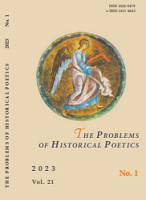Реализм Достоевского: продолжение спора
Dostoevsky’s Realism: Continuation of the Dispute
Author(s): Oleg I. SyromiatnikovSubject(s): Christian Theology and Religion, Russian Literature, Eastern Orthodoxy, Sociology of Literature
Published by: Петрозаводский государственный университет
Keywords: F. M. Dostoevsky; Russian Literature; God; Christ; Christianity; Orthodoxy; spiritual Realism; Christian Realism; Orthodox Realism; fideistics;
Summary/Abstract: The aim of the article is to determine the connection between F. M. Dostoevsky’s creative work with the phenomenon denoted in the modern literary studies by the terms of “spiritual realism,” “Christian realism,” “religious realism,” “symbolic realism,” etc. The writer worked in the genre of realism, he called himself a realist, and it is easy to notice the features of social, psychological, philosophical and even political realism in his works. However, at the same time, there was always something else in them that was more significant and added unique originality to the writer’s works. Many modern researchers believe that the foundations of this phenomenon lie in the common cultural European Christian tradition. Having studied various research approaches with the method of comparative analysis, author of the article comes to the conclusion that the most accurate term denoting the features of Dostoevsky’s artistic method is “Orthodox realism.” The writer himself called his method “complete realism,” “realism in the highest sense,” absolutely rejecting the label of a writer-psychologist. This circumstance has attracted the attention of researchers more than once. While studying their points of view and analyzing Dostoevsky’s own views on the goals and objectives of artistic creativity, the author of the article concludes that “realism in the highest sense” is based on the principle of transforming the Orthodox view of the world into artistic imagery. Many features of this principle can be seen throughout Russian literature, but it was Dostoevsky who brought those features together, developed and strengthened the most productive of them, removed certain incidental and unsuccessful ones and created Orthodox realism as a full-fledged artistic method. Based on it, the novels of 1866–1890s and “The Writer’s Diary” were written.
Journal: Проблемы исторической поэтики
- Issue Year: 21/2023
- Issue No: 1
- Page Range: 140-161
- Page Count: 22
- Language: Russian

